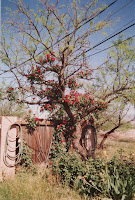Up until I began 4th grade down at Willard school, I did not associate that much with kids my age, especially girls, since the whole student body at my one room Camp Wood school was boys except for me and my memories of first grade are not a bit happy. But finally at Willard I had a chance to make girl friends. For the most part, they have all vanished from my life and I have not been able to track them down but I still remember Susan Ragle, Sandra Rhoton, Martha Etcheverry, Ann and Jan Stotts, Diana Metzgar, Della Kallsen and Melody and Dawn Wilcox--who gave me my first dog--with much fondness.
During the four years I was at Willard, we moved from Jerome down to Clarkdale and I lived in a neighborhood with quite a few kids. By chance most of them were younger than I was by a year or more but we still formed friendships that have held for many years even though we went our separate ways and lived very different lives. There I first met Loretta Watson who lived for a couple of years with her father a few doors up the street. She vanished suddenly and I later learned her mother had come and taken her; I am not sure if it was her father or a grandfather she lived with but he was quite elderly when she was nine or ten. She was a slender slight girl with long dark hair and very dark eyes although she did not look Mexican American or even Native American. She was also shy and a bit unsure as I was so we made timid freinds.
Then I met two other girls who lived in the same area, Evelyn Graves and Arlene Blahnik. We were, like most kids in that tween stage back and forth with small feuds and fusses but generally stayed friendly most of the time. I was able to give them rides on some of my gentler horses, made and played paper dolls with them and a bit later read my early fiction efforts, short little tales that grew out of my reading of Zane Grey and similar writers of western adventures and romances. I watched TV at Arlene's house and giggled with Evelyn about imagined adventures and intrigues of her elder sister and her somewhat notorious employer and our crushes on various movie and TV stars and such.
It's been such a great joy to reconnect with them both at High School reunions since the first one I attended in 2003. I've also seen Kathy Feld, Janice Benatz and several other girls I knew and was friends with but not quite as close. My last two years of high school, Evelyn and Arlene were going with their future husbands and the three messkeeteers were not so close. I then found a friend who was also a semi cowboy-girl like I was and we were nearly inseparable until I graduated, two year before she and Evelyn did and for a time afterwards. I found a Maureen Jewell on Facebook who is involved with horses in Wyoming or Montana as I recall but she did not reply to my message. Perhaps she has forgotten. In that case I was the one who ended up taking a different path.
Early friends are not complete without one more mention. I loved to write letters and became pen pals with two girls through the junior section of Western Horseman magazine. There were more but two remain in contact after all these years. Shirl Atchley, nee Coulter still lives in the Grand Junction area of Colorado and only in the last few years due to health has given up owning a horse or two and riding. We still exchange Christmas cards and an occasional email. Linda Pflug, nee Bush, now lives in Washington state. We met several times but not until years after our initial connection. Until a few years ago we exchanged letters and then emails frequently. Then she had a series of serious health issues and today is bed ridden and in a nursing home due to several strokes and other issues. She cannot write or type much and has some speaking trouble so short of going up there to see her, I cannot do much to stay in touch. This makes me very sad but I still cherish that friendship. I'm sure we will cross paths and connect again in time.
As an adult while working, being involved in various organizations, hobbies and volunteer activities and moving to several places I have made many new friends and now keep in touch with many by Facebook or email, some that I have met and many more that I have not but just share some common interest, passion or belief with. They are all precious and form my essential support group and circle but I have to put my old BFFs at the top of the list. I know I will never forget them and for those who have lost contact or perhaps are no longer on this earth, I hope to renew our ties in some future place and time. Thanks to each and all of you for being a part of my life and bringing joy and beauty into it.
 |
| Evelyn Graves |
 |
| Shirl Coulter |
 |
| Maureen Jewell |
 |
| Susan Ragle |
 |
| Linda Bush |
 |
| Arlene Blahnik |




